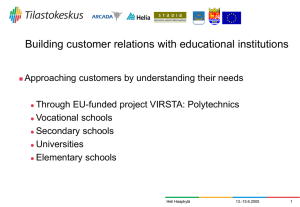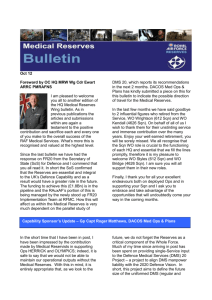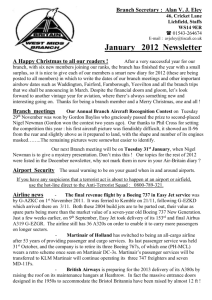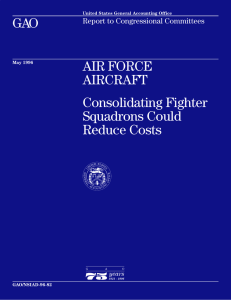apdf nov 4 - 1550 amarasena
advertisement
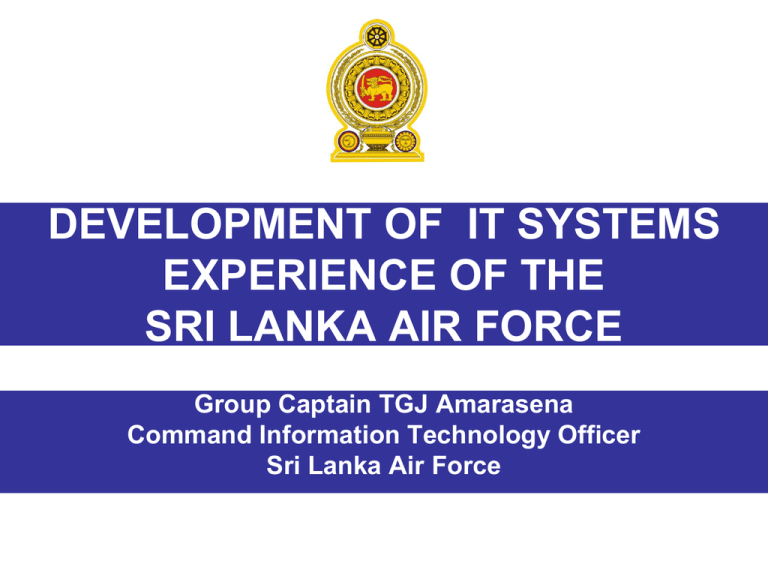
DEVELOPMENT OF IT SYSTEMS EXPERIENCE OF THE SRI LANKA AIR FORCE Group Captain TGJ Amarasena Command Information Technology Officer Sri Lanka Air Force Introduction India Sri Lanka Population 270 Miles 20,450,000 (432 km) Area 65,610 sq km Coastal Line 140 Miles (224 km) 1,340 km • • • • • • • • • 100 + Aircraft fleet 03 Fighter Squadrons 01 Attack Heli Squadron 02 Fixed Wing Transport Sqns 02 Heli Transport Squadrons 01 VIP Heli Squadron 01 Flying Training Squadron 02 UAV Squadrons 36,000 personnel - Air Force Headquarters - Major Air Bases with Aircraft Squadrons - Air Force Stations/Units with Airfields - Air Force Stations/Units – Training Facilities/Security Duties Mission "To achieve professional excellence in rapid mobility and precision engagement by developing core capabilities based on technological superiority, to ensure readiness and operational success in exploiting the competent human resources and equipment of the Sri Lanka Air Force" Vision "To be a well accomplished, resolute and an ingenious air power capable of fulfilling the aspirations of the nation and preserving the sovereignty and territorial integrity of the island" • Transformation into an effective and efficient fighting force. • Expansion of the aircraft fleet • Modernization of Systems • Introduce communication networks for both voice and data • Introduce computer based systems wherever possible • Train and educate the Air Force personnel on IT Systems Communication Networks In the 1980s the SLAF decided to implement its own communications network and not to depend on public infrastructure. The Voice/Data network covers most of the Bases/Stations/Units. The data network is based mostly on CISCO equipment and implemented with the assistance of private partners. Area under LTTE Control Area of OPS for ARMY DIVs SQN1 GCS1 SQN3 GCS2 GCS3 SQN2 HELI SQN GU 1 GU2 AFHQ NHQ AHQ B200 SQN GCS 1 GCS 3 Node 1 Node 3 Node 2 GCS 2 SQN 3 SQN 2 SQN 1 Node 4 Node 5 AFHQ B200 SQN Heli SQN • Two very high level Govt users • Army and Navy HQs • Four (04) Army Div HQs Primary Radar Data MAP DATA (RASTER) UAV IMAGERY VIDEO ARCHIVES BMCC 3D Radar Data SAT IMAGERY Integration of Radar Sensors Provide situational awareness by combining data received from several radar sensors and displaying them on a single screen Developed by the SLAF using .Net platform and WPF services. Data stream is transmitted through the SLAF network, intepreted and displayed at the client terminal. Network Security • Two physically separated networks • Intranet and Internet Access • Internet Access network attacked three times • Security needs to be enhanced IT Systems • An efficient mailing system was identified as a top priority requirement for supporting the operational efforts. • The solution has to meet the requirements of the ordinary mailing system as well as suit the requirements of two-way radio based messaging system 1998 Networked Users Microsoft Exchange Server 5.5 & Windows NT AFHQ Dial-up Users 140 Users Approx 6000 mails a day 2005 Networked Users Microsoft Exchange Server 2003 (Std Edt) & Windows Server 2003 (32 bit Std Edt) AFHQ Dial-up Users 170 Users Approx 8000 mails a day Networked Users Dial-up Users Microsoft Exchange Server 2007 Standard Edtion RMA Additional Domain Controller Primary Domain Networked Users Controller WIN-2003 (Ent 64bit) Microsoft Exchange Server 2007 Enterprise AFHQ Networked Users Microsoft Exchange Server 2007 Standard Edition Kat Additional Domain 2009/10 Controller 332 Users Approx 11000 mails a day • Next Upgrade - Planned in 2011 • Introduce a Document Management System based on Microsoft SharePoint to integrate the mail circulation, sharing and archiving features SLAF concentrated its efforts on three areas Equipment Provisioning & Accounting System EPAS ERMS HRMS Engineering Resource Management System Human Resource Management System • The first system to be deployed was the PAYADMIN System in 1990. • It computerized the payroll of 8,000 personnel. • It now handles the payroll of 36,000 personnel • The system was outsourced and has been very successful since its implementation • Both the Logistics and Engineering Management Systems were outsourced in 1994 • This project was scrapped in 2002. • An attempt was made to develop these systems in-house using SQL and Oracle but it failed • Both Systems were outsourced in 2008 (USD 320,000.00) but failed in 2009 due to the contractor being declared as bankrupt • In 2008 the Air Force decided; – Use a commonly available stable technology – Selected SQL Sever as the database environment – Use web based systems as much as possible – Selected .net platform as the development environment with C# and ASP as the main development platform – Air Force team should work with the contractor’s team so that the maintenance could be taken over by the Air Force Application Base#1 Application Base#3 DB#3 DB#1 DB#4 Application Base#2 DB#2 Application Base#4 Central DB Server HQ DB#5 DB#6 DBHQ Application Base#5 Mirror DB Application HQ Application Base#6 EPAS • Three major modules – Procurement Module – Material Resource Planning – Catalogue Cell • More 55,000 Aircraft related items • More than 18,000 other items • All requisitions are now carried out through the system • All Stores/Warehouses are now connected ERMS • Aeronautical ERMS – All aircraft Squadrons are connected – Tracking of life components – F700 – Servicing & Flying Records • General ERMS – Vehicle fleet management – Arms & Ammunition Management HRMS • • • • Personal Data of all Officers & Other Ranks From enlistment to retirement Initially developed using SQL and Oracle Converted to Microsoft Platform Challenges • Procure & Customize Systems, Develop if necessary • Working with partners • Changing the attitudes • Satisfying the customer requirements • Rapid advancement in Technology • Shrinking Budgets • Training Future Plans • Integrate the IT systems • The technology that was identified during the operations will be improved • Sea surveillance will be a primary task for the UAVs and the manned surveillance aircraft • Internet & Intranet Security • BMCC will be improved to include inputs from other sensors • Interoperability issues will be resolved • Military networks will be utilized to support civilian administration Thank You






